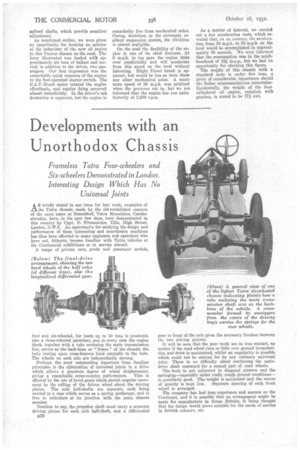Developments with an Unorthodox Chassis
Page 46

If you've noticed an error in this article please click here to report it so we can fix it.
Frameless Tatra Four-wheelers and Six-wheelers Demonstrated in London. Interesting Design Which Has No Universal Joints
liA S 'briefly stated in our issue for last week, examples of
the Tatra chassis, made by the old-established concern of the same name at Nesseldorf, Tatra Mountains, Czechoslovakia, have, in the past few days, been demonstrated in this country by Capt. D. Fitzmaurice, 122a, High Street, London, N.W.S. An opportunity for studying the design and performance of these interesting and unorthodox machines has thus been afforded to many engineers and operators who have not, hitherto, become familiar with Tatra vehicles at the Continental exhibitions or in service abroad.
A range of private cars, goods and passenger models, four and six-wheeled, for loads up to 10 tons is produced, also a three-wheeled parcelcar, and in every case the engine block, together with a tube enclosing the main transmission line, serves as the back-bone or "frame" of the chassis, the body resting upon cross-bearers fixed centrally to the tube. The wheels on each side are independently sprung.
Perhaps the most outstanding departure from familiar principles is the elimination of universal joints in a drive which allows a generous degree of wheel displacement, giving a remarkable cross-country performance. This is effected by the use of bevel gears which permit angrier movement by the rolling of the driven wheel about the driving pinion. The axle half-shafts are separate, each being carried in a case which serves as a spring anchorage, and is free to articulate at its junction with the main chassis member.
Needles's to say, the propeller shaft must carry a separate driving pinion for each axle half-shaft, and a differential B20
gear in front of the axle gives the necessary freedom between the two driving pinions.
It will be seen that the gear teeth are in true contact, no matter if the road wheel rises or falls over ground irregularities, and drive is maintained, whilst an angularity is possible which could not be catered for by any ordinary universal joint. There is no difficulty about continuing the maindrive shaft rearward for a second pair of road wheels.
The body is not subjected to diagonal stresses and the springing—especially under really rough ground conditions— is peculiarly good. The'weight is minimized and the centre of gravity is kept low. Separate steering of each front wheel is arranged.
The company has had long experience and success on the Continent, and it is possible that an arrangement might he made for manufacture in Great Britain, it being thought that the design would prove suitable for the needs of service in British colonies, etc.






































































































